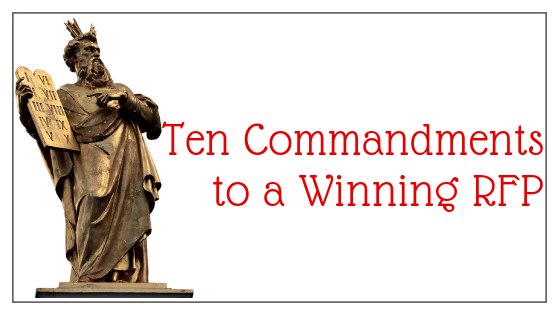Why Do you need to “run a WINNING RFP”
I’ve spent 30 years in the “agency business” (client services), and participated in literally hundreds of “pitches”. These pitches — initiated by receipt of the dreaded RFP — are a fact of life. Unfortunately, all too often, what the requestor is looking for and how to respond is not clear. The issue? Most businesses don’t know how to run a winning RFP.
Recently I took part in yet another RFP for a major national marketer that can only be considered a “fail” for all parties. Afterwards I began to think about the internal process of looking for a solutions provider. Why would a company even take the time and effort when requirements are often so opaque?
RFP? WTF?
In this most recent case there were multiple problems. The deliverables for the exercise were unclear All the competitors core competencies were quite different. In fact, no one company could deliver all the disparate services supposedly under review.
This is to say nothing about the need to respond with three different support documents in three weeks.
With this as background, I set out to help change the dynamics of RFPs. I created The 10 Commandments to Run a Winning RFP. Following these commandments delivers a more strategically sound RFP with the goal of providing optimal outcomes for both clients and providers.

I. Clearly Understand Why You Are Undertaking The Exercise
It might be counterintuitive to recommend starting with the end in mind, but that’s exactly what you need to do. Are you replacing a current supplier? If so, why? Maybe addressing current issues might be an easier, more effective way to proceed? The devil you know is often better than the devil you don’t. Are you looking for a new resource? Why, what exactly are your needs?
II. Lay Out What Success Looks like up front
Be sure you understand the specific objectives, and solutions you are trying to achieve? Without this, it’s like getting into the car and driving endlessly with no destination in mind.
III. Build internal consensus before you begin
Here’s where things start to get difficult. If procurement runs the solicitation, chances are low price is going to win the day. Alternatively, there are often conflicting perspectives on what is required from marketing, sales IT etc. Unless there is interdepartmental consensus, it’s hard to provide clear direction to RFP participants, and more important get internal cooperation once decisions are made.
IV. Structure the brief to clearly outline the need & requirements
In today’s complex, rapidly changing distribution channel and shopper environment, like manufacturers, service providers are struggling to keep their service offerings current and relevant. Respondents answer the questions that are asked, and assume you have done the homework required to identify the critical information you need. Unfortunately, this is often not the case. All too frequently, I have sat in conference rooms, or on calls, wondering exactly what solutions clients are looking for?
V. Select participants so as to expose a full palette of capabilities
In today’s complex environment there is no one way to get from “problem” to “solution.” Each participant will have their own thoughts about both processes and priorities. Homework must be done to be sure you are uncovering the spectrum of approaches and capabilities.
VI. Use cost as a level set vs. a deciding factor
While cost will always be an important consideration, focusing RFP’s as a quest to reduce service pricing is a critical mistake. There is a major difference between “low cost” and “best cost”. Understanding respondent’s perspective on the difference is critically important. You will not get the right answers without asking the right questions.
VII. Provide time to prepare the work
RFP responses throw a monkey wrench into workloads. Current client deliverables sometimes suffer, and late nights and weekends are frequently required. Without providing adequate time for reviewing questions, fielding research and developing well thought out solutions you will not get optimal thinking. After all, you are making long term decisions and commitments, allow time for participants to do their best work.
VIII. Have talent responsible for managing the discipline on the development team
I have always felt that people work best with people they like, or in this case respect. Chemistry should never be underrated. Often the difference between providers is the passion, and commitment they bring to their business. When members of the team that will be working directly with the provider are not in the room, experiencing firsthand the interaction, failure of the relationship is much greater.
IX. Provide clear feedback after each interaction
We feel this is a major missed opportunity to fine tune the process, and optimize interaction. Assessment of what seems to be working from initial distribution of the RFP, to question response and in-person presentations provide an opportunity for both discussion and response. In essence another chemistry check.
X. Close the process in a timely manner
All too often, there seems to be a rush to finalize the evaluation process, only to wait months for the decision. You have asked suppliers to put their businesses on hold, work without compensation, and often times travel to your location to pitch your business. Responding in a timely manner with both feedback and a decision is both polite and enables you to move forward with your new partner with adequate time lines.
Final Considerations to Run a Winning RFP
Consider it, running an RFP is a critically important component of the business cycle. It is an opportunity to provide your organization with a required discipline, as well as provide insights into how best-in-class resources are servicing clients and driving innovation. Not taking the time to think through both process and requirements are a significant miss.
An Offer of Help
It’s hard to get this right. After all, it’s taken me 30 years.
I’d like help you put the 10 Commandments to Run a Winning RFP into practice. I have developed a step-by-step process to identify “best cost” solutions and deliver optimal RFP outcomes. Drop me a note (jon@jmk-solutions.com) for a free 30 minute call to discuss how to optimize your next RFP. After all, 30 minutes could save you hours later.





